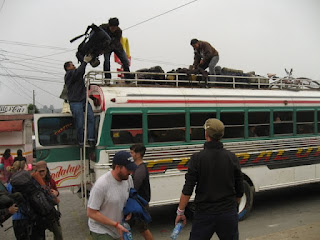A lot more than just a desert of salt, Uyuni
After a long bus journey through some of the best Bolivian roads (still just another good dirt road where bridges are built by it's users, see last post), we finally arrived at the town of Uyuni where we had booked a 3 day tour to the Salt flats.
I have to admit that I had some expectations on this place, I had made the mistake of checking some pictures online and all of them looked beautiful, almost like from an unreal place. What I was not aware of was the extension of the place, what the exact route would be and what it would feel like to be there, so it was with a big surprise that during the next 3 days I found myself in the middle of volcanoes, beautiful colourfull lagoons and thermal springs.
Our first problem in Uyuni was how to get out of there, the town itself has not much to offer apart from a good starting point to the Salt Flats tour, so the first thing we tried to do when we got there was to book our train ride out of there for 3 days later. Surprise: everything was fully booked. So we wondered during the next half hour what the solution would be: taking the bus instead, waiting 2 extra days for the next train or trying to fix our tour to finish in the border with Chile and find a solution from there. Luckilly our tour operator had booked extra seats on the train, so we were promissed that there would be no problem for us to travel on the wanted date but under some other person's name.
Everything sorted out and we were sitting inside a jeep with 5 other people and a driver, while our guide was in another jeep with 6 people more. First stop, the driver's house to pick up some food and a plastic bag full of coca leaves that he kept on chewing through all the 3 days. The first 'real' stop was the 'trains cementary'.
Here we've seen the remains of old trains covered with rust, in what once was an important repair point for trains of the mining industry.
After that we went for lunch in a salt hotel in the middle of the salt flats, and we had our first lama steak. We played with the illusion created by the homogeneous background, and tried to take cool pictures.
From there we left most of the crowd behind and headed to the 'isla pescado'. Since it had rained some days becofore, most of the salt flats were inundated going there, and we were very lucky that our tour operator was still crazy enough to drive for those next 1.5 hours. The reason why they are called salt 'flats' was explained, as for kilometers after kilometers we drove the jeep over a layer of about 10 to 30 centimeters of water on top of the flat salt surface, this made any ripple created in the water to be damped really fast. The result was a perfect mirror that seemed to double the horizon and a sensation of floating over the sky.
We finally arrived to isla pescado, an island once covered by coral reefs, which is now inhabited by giant cactus. It also used to be an important place for the inkas, to somehow connect with one of their gods, the mother earth (pacha mamma) and ask for a good year of crops by making some offerings and rituals. It sure felt like a special place, being in the middle of a desert of salt covered with water that reflected the skies, at about 3500 meter of altitude in an island covered by coral reefs and giant cactus.
It was difficult to leave such beauty behind, but after some time it would get dark and would be difficult to find our way back to 'firm land' in such an absence of reference points.
We made it back to another salt hostel just before the sunset.
The skyes here were particularly beautifull, with some vivid colors and snow-capped mountains far away in the horizon. As the night arrived we shared some travellers stories around a salt table with the other travellers.
























Comments
(We are now in Rio. From the street party I hear singing "cidade maravilhosa, cheia de encantos mil(...)). Very difficult to capture the feeling in pictures.
Beijinhos e continuação de boa viagem.